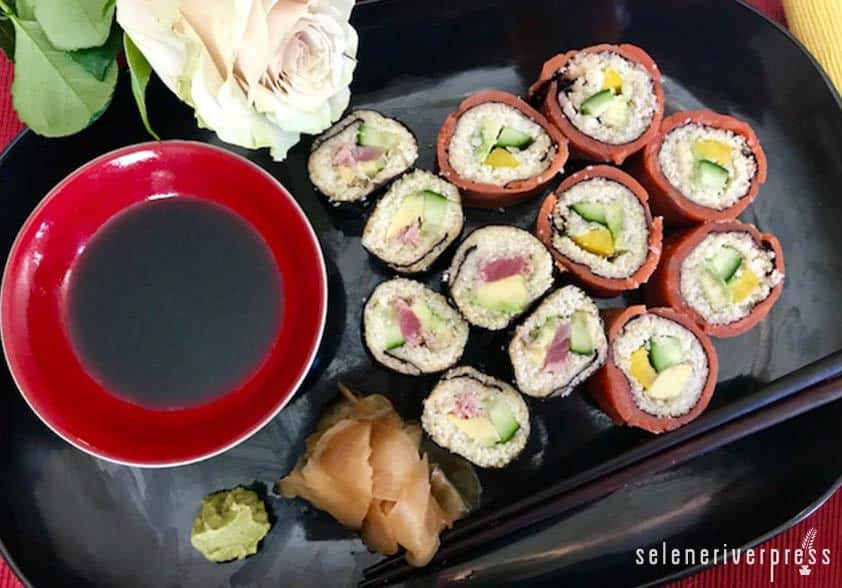Versatile and tasty, cauliflower “rice” is one of the newest trends of the times. Formerly confined to a scant few home kitchens, it’s now making waves in the marketplace. You can even find it, premade and packaged, in some grocery store aisles. It’s essentially nothing more than plain old cauliflower that’s pulsed in a food processor to look like rice and then subbed into your favorite recipes instead of such. I’ve experimented with it in countless ways, and I have a particular affinity for it in Chinese fried rice.
I adore experimenting in the kitchen, and I’m fond of fusion cuisines and combining flavors that would normally be off limits in conventional culinary circles. I also love making ingredient swaps, and I enjoy the mystery that comes with the interaction of unique flavors and textures. Eight times out of ten, my trials result in some degree of success. Though not every attempt is worthy of recreating, I’m always glad I tried, and every so often I’m blown away by the results of one of my whimsical experiments. This is true of the following dish, which, I’ve got to say, might be one of my favorite substitution recipes to date.
But before we get to the recipe, I must warn all of you who are new to the practice of ingredient substitutions:
Don’t expect your substitution to act, smell, taste, or feel the same as the ingredient you’re replacing!
Else, you’re bound to be sorely disappointed.
Cauliflower doesn’t share the same starch content as rice. It doesn’t have the same neutral flavor, taste, or texture as rice. It doesn’t soak up sauce the same way, and you don’t cook it the same way. In fact, cauliflower would be terribly overcooked and mushy if you steamed or sautéed it for too long. In other words, it will not fool you into thinking you’re eating rice. But if you enjoy it for what it is, without expecting it will be similar in any way to rice, cauliflower makes a mighty fine alternative. And in the process, it tucks additional vegetable servings into your diet.
While we’re on the topic, please don’t try convincing anyone that they can’t even tell the difference between other ingredient swaps. Like, say, traditional durum wheat pasta for spaghetti squash. Your argument is set up for failure from the start. And if you truly can’t tell the difference, something’s amiss with your senses.
I prefer to enjoy food for what it is: creative, nourishing deliciousness. Free from labels, anticipations, and projections. When I’m trying to persuade someone to try a new food—especially a food substitution—I tell them to enjoy it without any expectation of how it should taste and simply savor it for what it is.
Cauliflower and Sushi
After many experimentations subbing cauliflower for grains, I’m surprised that it took so long for the notion of using it in sushi to cross my mind. But once the thought entered my brain, I just had to try it.
First of all, I love cauliflower because it’s an enjoyable vegetable with exceptional flavor and flexibility. It also defies many conventional rules—kind of like me! We’re told that the darker the plant, the more nutrients is contains, and that we should focus on foods with lots of color. Yet cauliflower gives a big middle finger to all of that. For not having any pigment, it’s insanely nutrient dense. Maybe not quite as much as some other brassicas, such as broccoli and kale. But in terms of vitamin and mineral content, it’s definitely up there on the list of top performers.
Secondly, I’m a huge fan of sushi. I love the delicate balance between the briny seaweed, salty tamari, sweet and tangy pickled ginger, and fiery wasabi. It’s satiating without feeling heavy, and with its vitamin-rich seaweed, fresh, colorful veggies, and nutritious wild fish, sushi makes for an incredibly healthy meal or snack.
Sushi purists would likely balk at this, but I don’t consider rice terribly integral to the dish as a whole. Swapping it for nutrient-packed cauliflower was a pretty simple call for me. The flavors I love are all still there, and the cauliflower version is even lighter and more refreshing than its traditional counterpart.
The biggest hurdle with the cauliflower is that it doesn’t stick together like rice, especially sticky sushi rice. My rolls don’t have the same integrity or sturdiness of traditional sushi. The cauliflower flavor is slightly apparent, but the other flavors are so bold and assertive that it nearly blends right in. I chose a cold-smoked sockeye salmon and an amazing tuna product I found in the freezer section of the seafood department. It comes already sliced into serving pieces, lightly seared on the outside but still rare on the inside, with a hint of smoke. Perfect for speedy sushi at home! I had avocado, cucumber, and bell pepper on hand, but your filling possibilities are endless. Make your rolls vegetarian if you please. Try raw or cooked seafood. Or enjoy any manner of vegetables, condiments, or fruits (mango is one of my all-time favs). You can even give meats a shot if you want to.
I keep my sugar consumption on the low side, but to me sushi just isn’t sushi without pickled ginger, so I make an exception here. Gratefully, I found this high-quality pickled ginger, low in sugars and prepared with whole ingredients (just a heads-up, it’s not grain-free for those of you who care). This delicious premade product has even inspired me to concoct my own homemade pickled ginger recipe down the road…future blog post?! Eden’s wasabi is also very good, unlike many of the other prepared pastes and powders on the market that contain artificial colors and preservatives. Plus it comes in tiny little jars, so it’s easy to use up before it goes stale and flavorless.
For those of you who haven’t ever made sushi at home and are wary of the work involved…don’t be intimidated! It’s far simpler than it may seem. A sushi mat isn’t mandatory, but it does make rolling and obtaining symmetrical rolls easier. They’re relatively easy to find and inexpensive online and even at some grocery stores.
Sushi with Cauliflower Rice
Makes 2 whole rolls (about 16 pieces total)
Prep time: 20 minutes, with approximately 60 minutes chill time
Cook time: 15–20 minutes
Ingredients
For the rice:
1 small cauliflower, pulsed in food processor or grated by hand until it resembles rice grains
Rice vinegar to taste (I used about 1½ tablespoons)
Stevia, honey, or other sweetener of your choice to taste (I used a single drop of liquid stevia)
Sea salt to taste
2 sheets nori
Optional fillings (use what you like best):
1 avocado, peeled and sliced
½ small cucumber, cut into batons
½ bell pepper, sliced
4 oz. cold-smoked salmon
3 oz. tuna, raw or lightly cooked
For serving: pickled ginger, tamari, and prepared wasabi
Special equipment: sushi mat and steamer basket
Instructions
- Place riced cauliflower in a steamer basket within a small pot filled with about an inch of water. (If you don’t have a steamer basket, place cauliflower in pot with about an inch of water.) Cover pot and bring to a boil. Reduce heat and steam until tender, about 15–20 minutes. Drain well and place in a bowl. Add rice vinegar, sweetener, and salt to taste. (You want it to taste faintly tangy and slightly sweet-salty.) Set aside to cool, or if you’re in a hurry, place in fridge or freezer to speed up the process.
- Meanwhile, prepare your fillings. Cut all seafood and veggies into strips and set aside. Prepare wasabi according to package directions and set aside.
- When ready to roll, place a sheet of nori on sushi mat (bamboo strips should run from right to left). Divide cauliflower in half. Using your hands, press one half of the cauliflower evenly over the lower ¾ of the nori. Arrange your filling ingredients from right to left across the roll, about 1/3 of the way up the sushi mat away from you.
- Wet your fingertip and rub the top edge of bare nori with water to soften it. (This helps the nori stick to itself and seal your roll.) Using even pressure and the assistance of your sushi mat, roll the lower part of the cauliflower- covered nori up and over the filling, slightly tucking and pulling back as you roll the sushi away from you. Allow the dampened edge of the nori to seal the roll. Set aside, seam side down, on a plate. Prepare other roll or rolls.
- For an inside out roll: lay a piece of plastic wrap on your sushi mat. Arrange smoked salmon slices in an even layer, slightly overlapping, to about the size of ¾ of the nori sheet. Top salmon with nori, then cauliflower rice, then your filling ingredients. Roll sushi as directed in step 4.
- Chill prepared rolls in the fridge, loosely wrapped, for about 30 minutes. When ready to serve, slice each roll into 8 pieces and arrange on a platter. Serve with garnish and condiments of your choice.

Image from Briana Goodall.



